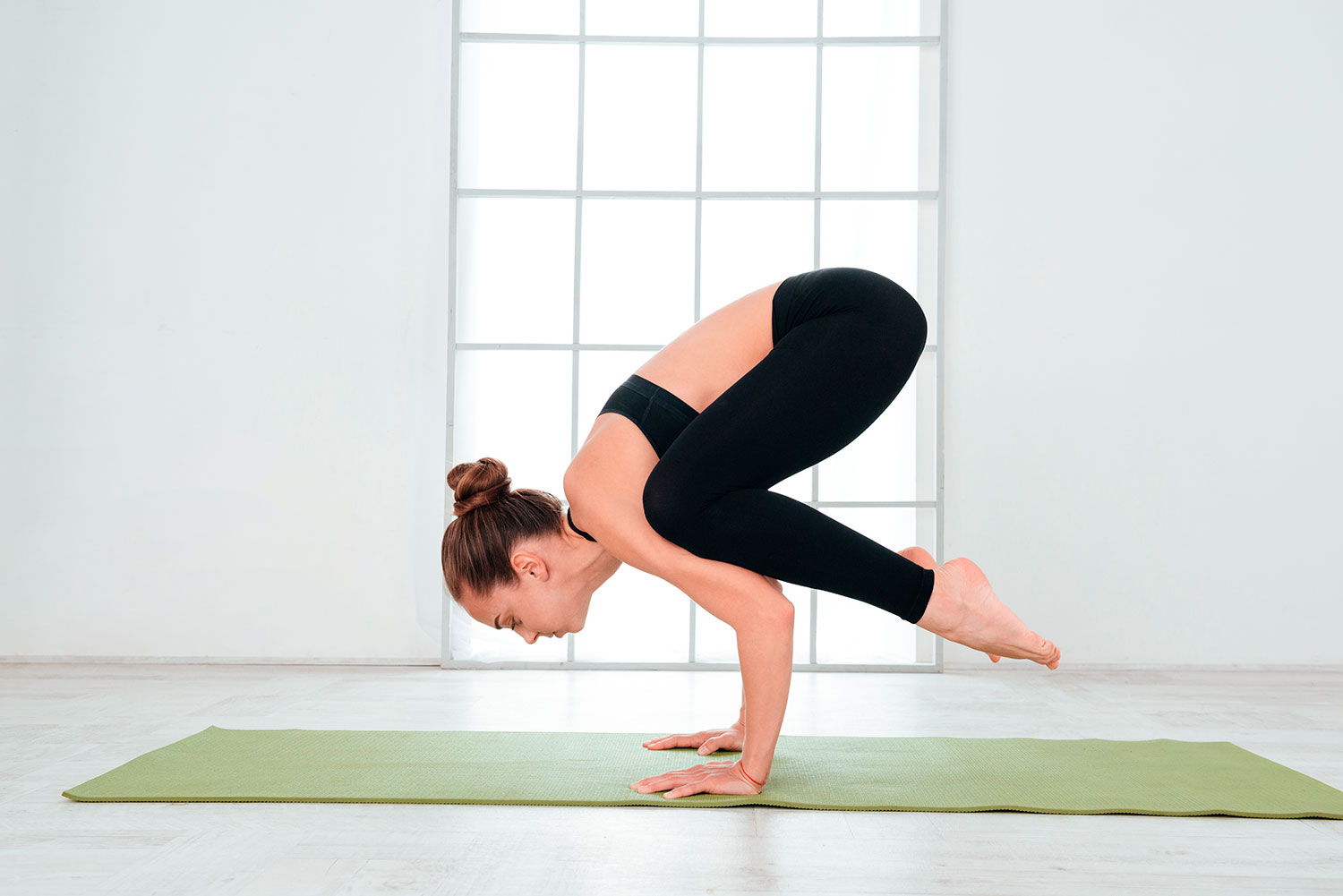
Yoga, meditation, and spirituality are at the top of the…
Practicing yoga is incredibly beneficial for your spiritual, mental, and physical health—so much so that many people choose their practice as their sole form of fitness. While yoga can undeniably keep you in shape, there is so much to be gained by exploring physical fitness options off the mat that can help you better serve your practice on the mat. Strength training is a great choice if you want to simultaneously elevate practice and boost your overall fitness. Adding strength training to the mix can help you deepen your practice and push your physical boundaries and perceived limitations—and it even has some surprising mental benefits, as well.
Reach New Poses

From chaturangas to plank poses, building strength is a key part of most yoga classes. However, a separate strength training routine can help you develop muscles that you don’t often work in the studio, and focus in on expanding physical power in certain parts of your body. Building up strength will enhance your practice on the mat—by focusing on building muscle, you will be able to get to the physical point that you need to attain in order to hold challenging poses that you may have not been able to reach before.
Round Out Your Workout Routine

Yoga classes can provide everything from an aerobic workout, to strength building, to a spiritual practice. Many people get the workout they feel they need from just taking yoga classes alone. However, depending on the classes and styles that your partake in, you may not get the full body workout that you need just from your yoga practice.
It is recommended that healthy adults fit in strength training at least twice a week in order to create an efficient and effective workout schedule. Incorporating strength training into your workout routine can help fill in the missing piece and create a well-rounded regimen that gets your heart pumping, muscles working, and mind cleared. Just as importantly, having variety in your workout routine will help keep you motivated to continue your physical fitness journey, as the diversity will help you avoid feeling like you are in a rut from a monotonous schedule.
Combat Muscle Loss
Muscle mass and strength loss is something that affects us all as we age. The decrease in our muscles starts to occur in our 30s. By the time we have reached age 75, approximately 50% of our total muscle mass has diminished.
This decline is natural and unavoidable, but there are ways to limit the amount and speed in which it occurs. In order to slow the effects of aging on your muscles, yoga and strength training can be combined to create an effective workout combo that helps you keep your muscles in great shape. In a study, strength training has been proven to be a useful tool for counteracting loss in strength and muscle mass in older adults. Similarly, in another study, researchers found that older women were able to preserve muscle mass by practicing yoga at least two times a week.
In order to offset the effects of aging on your muscles, try adding strength training to your physical activity to maximize your efforts and keep your muscles healthy and happy.
Maintain Strong Bones

Osteoporosis, a disease that makes your bones weaker and more susceptible to fracture, affects approximately 10 million Americans. An additional 44 million people have low bone density, meaning they are at a higher risk of the disease.
The benefits of yoga are extensive. However, depending on the nature and intensity of your yoga routine, your practice may not be doing enough to keep your bones strong. Research has proven that a consistent yoga practice can reverse bone loss, but you may need to supplement your physical routine with strength training to ensure you are giving your bones the attention they need. In order to increase your bone mineral density, add a consistent weight training routine to your workout schedule.
Lower Risk of Injury
Yogis are particularly prone to injury, especially when trying unfamiliar poses or pushing a posture too far. By adding weight training to your routine, you are strengthening different parts of your body to help reduce your risk of injury during your practice—as well as during any other physical activity you may partake in.
The ways in which strength training can reduce your risk of injury are varied. As mentioned, strength training can help increase your bone mineral density, making your bones stronger and less susceptible to fracture. It also helps with maintaining or increasing muscle mass and, as a result, strength. In addition to bone and muscle health, strength training increases both the size and strength of your connective tissues, further keeping your bones and muscles protected and well-functioning. It is essential to keep all of these components of your body strong in order to lower your risk of injury and keep yourself as safe as possible during your practice.
Increase Flexibility

When you think of ways to increase flexibility, yoga is probably the first method that comes to mind. However, if you’re trying to work towards touching your toes or doing a backbend, you can look at some strength training options off your mat to reach your goals.
In a study, researchers followed a group of people on a strength training regimen, as well as another group of people who did basic static stretching routines over a period of 5 weeks. They found that both groups showed similar improvements in flexibility in their hamstrings, hips, and shoulders at the end of the study (compared to a control group who did not have a routine assigned to them), proving that strength training can be just as effective in improving flexibility as stretching. If you’re looking to increase your flexibility, mix up your routine and implement some strength training moves.
Improve Body Awareness
Body awareness is incredibly important in yoga. As you are trying new poses or going deeper in postures, you need to know the physical limits that you have, so as to not push yourself too far and risk strain or injury. Our bodies are constantly changing, and we won’t be at our peak every day, so it important to be able to assess where you are physically every time you practice to know what your body needs and can handle at that moment.
By implementing strength training in your life, you will further develop your body awareness. As you work new muscles and try new methods of exercise, you’ll begin to discover the limits your body has—as well as surprise yourself as you go beyond the limits you were previously stuck in. Use strength training as a tool to become more in tune with your body, and you’ll find that awareness on your mat as well.
Manage Weight

Strength training is great for people looking to maintain their weight or shed a few pounds, because it helps boost your resting metabolism—the rate at which your body burns calories as you are going about your day. More physically intense forms of yoga can help with boosting metabolism and managing weight, but strength training is particularly effective because your body continues to burn calories after the session. This occurs because your body is still in working mode to help with muscle recovery, through a process called excess post-exercise oxygen consumption.
Furthermore, a recent study on dieters looking to lose weight found that, over a period of 18 months, a group that did strength training exercises four times a week lost more fat than the aerobic exercise group and no exercise group—proving that strength training is a highly effective weight-loss tool.
If you turn to yoga for weight management, try implementing strength training into your routine to help you round out your workout style and reach your goals.
Tone Muscles
Just as you may do yoga to manage your weight, you may also practice in order to get more definition in your muscles. If you are looking to add shape and strength to your muscles, consider trying out weight training in addition to your yoga practice. This combo will help you stretch, lengthen, and strengthen your limbs, giving you to definition you are working towards, while also progressing your physical limits.
Improve Balance

Balance is central to any yoga practice. A strong sense of balance helps you go deeper into your practice and stay stable in challenging poses. Strength training helps you to improve your balancing skills, allowing you to enhance your practice on the mat. In a study of a group of people ages 65 to 82, it was found that those who participated in strengthening exercises were able to improve their balancing abilities, lowering their risk of fall and injury.
Improve Coordination

Coordination and balance go hand in hand in yoga, so it is equally as important to work on your coordination skills. Thankfully, a consistent strength training routine will help you do just that.
Researchers studied a group of pool players, giving half of the study participants a strength training regimen to follow over the course of 12 weeks, while the other half continued their pool training as usual. It was found that the participants in the strength training group were able to significantly improve both their coordination and reaction time skills. This led researchers to suggest that any athletes participating in coordination-heavy sports should commit to a consistent strength training routine to step up their performance.
Improve Posture
Good posture is important, and not just because it makes you appear more confident. Poor posture can negatively affect your health, from causing back pains to headaches and neck tension.
Both yoga and strength training are excellent methods for improving your posture. Specific yoga poses have been proven as effective tools for reducing pain and bettering posture, while a strength-focused exercise program has been studied and found to provide the same benefits. Combining the two in your physical routine can help ensure you are consistently maintaining a healthy spine, both as you are physically challenging yourself and as you are casually going about your day.
Build Endurance

Yoga is commonly viewed as a light workout to people unfamiliar with the practice, but those people often don’t realize just how much endurance a class can require. Holding poses for an extended amount of time, as well as pushing yourself to make it through one more standing series before savasana, can require a lot of stamina. If you want to find more power on the mat, you should work on your endurance off the mat.
Strength training can be the key to finding more energy in your practice. Working through multiple reps will help you build up your power. Over time, you will start to see yourself build upon the amount you can take on in your strength training, and those capabilities will start to translate onto the mat.
Ignite Focus
Yoga is touted as an excellent way to center your focus. Breathing and moving through asanas pushes you to leave your thoughts at the door in order to be fully present in your practice. That same focus can be used and enhanced in a strength training workout. As you are working through reps, you need to push through the difficult movements, focus in, and not allow a limiting mindset to stop you from completing your set. By igniting your focus through strength training, you can bring in a new perspective and dedication to your mat.
Boost Mood

If you have a consistent yoga practice, you probably have first hand experience with how it can make you happier—and there are studies that can backup your experience. Physically moving through asanas results in an increase in serotonin, commonly referred to as the “happy hormone”.
Strength training, on the other hand, helps elevate the levels of endorphins in your body. Endorphins have a multitude of functions, from relieving stress and anxiety levels to alleviating depression and minimizing pain. Combine yoga and strength training, and you’ll have both a well-rounded mental and physical routine.
The benefits you reap on the mat are likely what keep you coming back to class time and time again. If you want to take your practice further and elevate your skills, add strength training to your physical fitness to fully round out your routine. Over time, you’ll see your practice evolve, and will be able to push past physical limitations that were previously in place.
What's Your Reaction?
Yoga, meditation, and spirituality are at the top of the list for writer and former nutritionist Amanda Carter. This devoted practitioner enjoys writing about health and wellness just as much as she enjoys living it.















thanks for sharing your post.